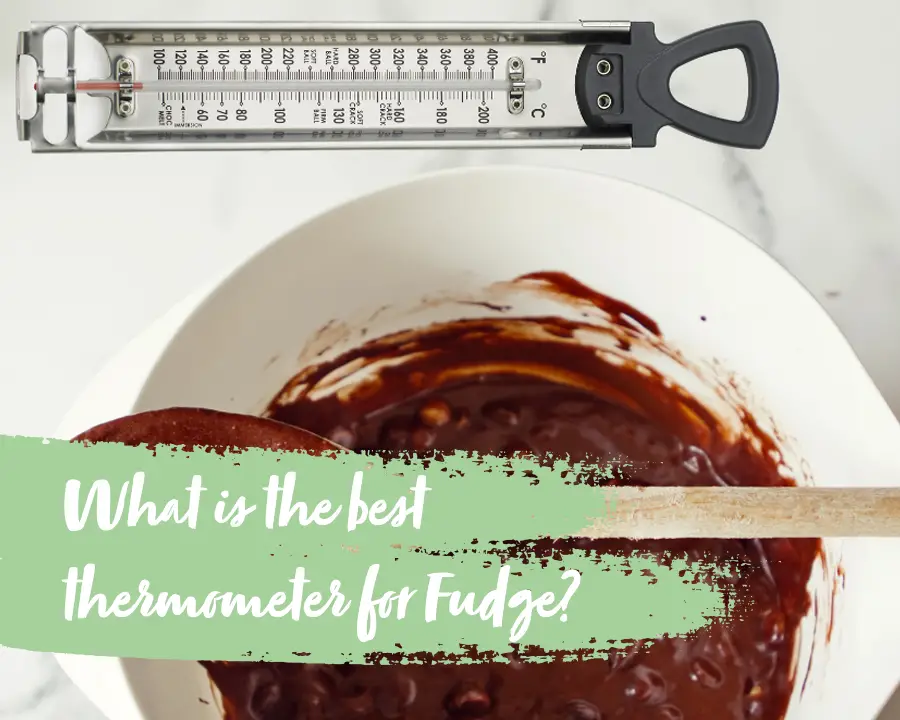Making your own desserts at home is fun, satisfying, and often very tasty.
Not all sweet treats are simple to make and some delicacies like toffee, caramel, and fudge need to be cooked at very specific temperatures to achieve the right texture.
Fudge in particular is not a recipe where you can just rely on the cooking time to know when it is done. To make this recipe correctly, you will need to carefully monitor the temperature of your mix during cooking and cooling.
This calls for a thermometer, but you can’t just use any old one you have lying around the house.
Most domestic thermometers are too short for making deserts and you risk having boiling hot sugar or chocolate bubble up onto your hand if you use them for this purpose.
To avoid ruining your fudge, and giving yourself a second or third-degree burn in the process, you should always try to use a proper sugar thermometer.
What Is A Sugar Thermometer?
A sugar or candy thermometer is specifically calibrated for measuring the temperature of hot sugar. As such, they can measure a much higher range of temperatures.
Since sugar can easily get above 200°F/ 93°C when heated, using a regular domestic thermometer, or one designed for meat, won’t be sufficient for making most desserts.
Candy thermometers can measure up to 58-572°F/ 14- 300°C and have extra long stems so you can keep your hands at a safe distance from the molten chocolate or sugar you are handling.
Here are some of the most important features of a good candy thermometer to bear in mind before we get into our top picks.
Accuracy
Fudge needs to be heated between 234 and 237 °F/ 112 and 114 °C before it is ready. To know when you have reached this temperature, you will need a thermometer that can give precise readings.
Digital thermometers are generally more precise than the analog variety and they are much easier to read since you don’t have to squint at a tube or dial.
Durability
Needless to say, you want your thermometer to last you many years of happy dessert making. However, it is also essential that your device doesn’t break during cooking. Shattered glass and alcohol are a sure-fire way to ruin your fudge.
It should go without saying that you should never use a mercury thermometer for handling hot sugar for this very reason. If you do pick an analog candy thermometer then you will need to make sure it is sturdy and unlikely to break.
Speed
Fudge and other sugary recipes are very delicate, and a few degrees in the wrong direction can spell the difference between success and failure.
As such you need a thermometer that gives accurate readings quickly rather than one that takes a few moments to settle at the correct temperature. Again digital models are best for this, but some analog ones can work just as well.
Now that you know what to look for in a good candy thermometer, let’s jump right into our top picks for the best thermometers to use while making fudge.
1. Taylor Precision Products Classic Line Candy Thermometer
No products found.
Taylor produces a wide range of accurate analog thermometers that are perfect for making any kind of complicated dessert.
This model comes with a helpful guide on the case that lists the specific temperatures of the different stages in the candy-making process.
Just a quick look at the tube will tell you how hot you need to make your mix for it to enter the soft ball, hard ball, or hard crack stages of cooking.
There is an adjustable clip on the side for attaching this thermometer to the side of your cooking pot. You should always take readings from multiple areas in the pot to ensure a consistent temperature throughout your mix.
That said, the clip will help to hold your thermometer steady so you can accurately monitor how your fudge is coming along
Pros:
- Can be clipped onto the side of a pot.
- The case has a temperature guide showing the different stages of cooking candy.
- A highly accurate gauge that measures temperatures between 100 and 400°F
Cons:
- This thermometer may be too short for some pans.
2. CDN DTC450 Digital Candy Thermometer
No products found.
This thermometer also has a helpful temperature guide on the sheath however, the writing is so small you may need a magnifying glass to read it.
Aside from this minor complaint, you can use this device to accurately read temperatures between 40- 450°F/ 4- 227°C.
The LCD digital display is very large and easy to read with a metal guard directly beneath it to protect your hands from bubbling sugar or chocolate.
There is also a stainless steel clip on the stem for attaching this thermometer to the side of your pot.
This model has seven pre-programmed candy stages as well as an alarm for telling you when your mix is at the right temperature.
Pros:
- Long stem with clip for attaching this device to the side of a pot.
- Large easy to read digital display.
- Alarm to tell you when your sugar or chocolate is at the right temperature.
Cons:
- The temperature guide on the case is hard to read.
3. Lightbeam Digital Candy Thermometer
No products found.
Stir your fudge mixture and monitor its temperature all at once with this innovative combination spatula and candy thermometer.
The probe runs the whole length of the silicon spatula and is controlled by two buttons at the top of the handle.
You can easily remove the probe from the rest of the spatula for cleaning, and it is recommended that you do so since the display is not fully waterproof.
The thermometer has a temperature range of 58- 572°F/14 – 300°C which is more than enough for making fudge and other sweet treats.
Since the spatula is made from silicon it can easily withstand the highest temperature that the probe can read, so you won’t need to worry about it melting.
Pros:
- Handy spatula and candy thermometer all in one.
- Great temperature range.
- Two-button operation.
Cons:
- The display at the top is not waterproof.
4. Taylor 9839-15 Adjustable Head Digital Candy Thermometer
No products found.
Another thermometer made by Taylor, but this time a digital one, the 9839-15 is a useful tool to have for making any dessert.
It can provide accurate readings for any temperature between -40- 500°F/ -40- 260°C, which makes it great for meats as well as candy.
The large LCD display is very easy to read due to its size and the way you can swivel it to face the right direction.
There is a metal clip on the stem for attaching this device to the side of your pot, although it isn’t recommended to leave it in the pot while you are stirring.
If you knock the probe with a wooden spoon or spatula the thermometer may become unclipped and fall out of, or into, the pot.
Pros:
- Large easy to read digital display.
- Made from durable stainless steel.
- Great temperature range.
Cons:
- Poor quality clip.
5. Polder Candy/Jelly/Deep Fry Thermometer
No products found.
Our final candy thermometer is an analog version made by Polder. Despite not having a display, this device is still very easy to read thanks to the clearly marked out temperature zones on the metal case.
There are six zones for telling you when a mixture has reached the thread, soft ball, hard ball, soft crack, hard crack, and deep fry stages of cooking.
An insulated handle has been placed at the top to make this thermometer safe to hold without burning yourself. There is also a metal clip on the back for attaching this device to the side of your pot.
Thanks to its flatter shape there is no chance of this thermometer becoming unclipped and falling into your pot.
Pros:
- Great display for seeing the different temperature stages of cooking candy.
- Insulated handle.
- Sturdy pot clip.
Cons:
- In some thermometers, the red fluid may separate which will lead to inaccurate readings.
Frequently Asked Questions
What Is The Correct Temperature For Making Fudge?
To make the perfect fudge, you will need to monitor the temperature of your mixture at two crucial stages, while it is cooking and again while it is cooling.
You will know your fudge mixture is ready when it has reached the soft ball stage between .
Without a thermometer, you would know you had reached this stage by dropping a small amount of mix into cold water; if it forms a soft ball, then your fudge is ready.
The next step after heating the mix is to beat it with a whisk, but first, you will need to wait for it to cool. The correct temperature to start beating your fudge at is 109 to 113 °F/ 43 to 45 °C.
What Do Candy Thermometers Use Instead Of Mercury?
Obviously analog candy thermometers can’t use vials full of mercury like some domestic models, in case they break and spill poisonous liquid metal into your food.
Instead, most of these devices will use digital displays or colored alcohol instead.
Some non-mercury thermometers will use a special substance called Galinstan made from tin, indium, and gallium. Galinstan is non-toxic and will pass through the digestive system with no negative effects.
IN SUMMARY
Traditionally, candy thermometers are used in making hard and soft confectionaries such as toffee, brittle and our favorite FUDGE. In fudge making a candy thermometer is one of the key tools in creating the perfect sugar molecules for the perfect fudge texture. However, if you’re up for taking a risk there is always the soft ball method to fall back on.
Last update on 2024-07-14 / Affiliate links / Images from Amazon Product Advertising API


